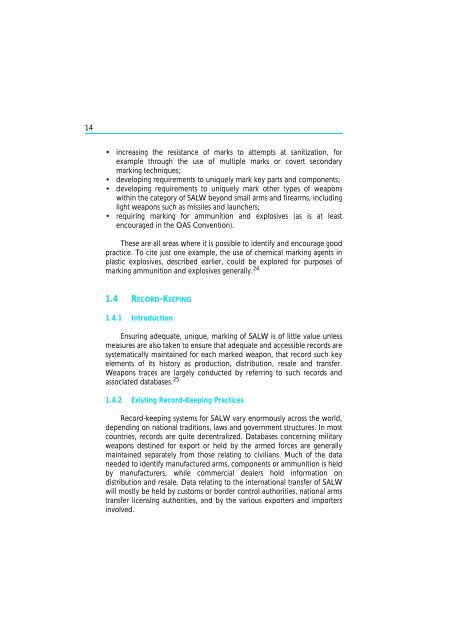The Scope and Implications of a Tracing Mechanism for Small Arms ...
The Scope and Implications of a Tracing Mechanism for Small Arms ...
The Scope and Implications of a Tracing Mechanism for Small Arms ...
Create successful ePaper yourself
Turn your PDF publications into a flip-book with our unique Google optimized e-Paper software.
14<br />
• increasing the resistance <strong>of</strong> marks to attempts at sanitization, <strong>for</strong><br />
example through the use <strong>of</strong> multiple marks or covert secondary<br />
marking techniques;<br />
• developing requirements to uniquely mark key parts <strong>and</strong> components;<br />
• developing requirements to uniquely mark other types <strong>of</strong> weapons<br />
within the category <strong>of</strong> SALW beyond small arms <strong>and</strong> firearms, including<br />
light weapons such as missiles <strong>and</strong> launchers;<br />
• requiring marking <strong>for</strong> ammunition <strong>and</strong> explosives (as is at least<br />
encouraged in the OAS Convention).<br />
<strong>The</strong>se are all areas where it is possible to identify <strong>and</strong> encourage good<br />
practice. To cite just one example, the use <strong>of</strong> chemical marking agents in<br />
plastic explosives, described earlier, could be explored <strong>for</strong> purposes <strong>of</strong><br />
marking ammunition <strong>and</strong> explosives generally. 24<br />
1.4 RECORD-KEEPING<br />
1.4.1 Introduction<br />
Ensuring adequate, unique, marking <strong>of</strong> SALW is <strong>of</strong> little value unless<br />
measures are also taken to ensure that adequate <strong>and</strong> accessible records are<br />
systematically maintained <strong>for</strong> each marked weapon, that record such key<br />
elements <strong>of</strong> its history as production, distribution, resale <strong>and</strong> transfer.<br />
Weapons traces are largely conducted by referring to such records <strong>and</strong><br />
associated databases. 25<br />
1.4.2 Existing Record-Keeping Practices<br />
Record-keeping systems <strong>for</strong> SALW vary enormously across the world,<br />
depending on national traditions, laws <strong>and</strong> government structures. In most<br />
countries, records are quite decentralized. Databases concerning military<br />
weapons destined <strong>for</strong> export or held by the armed <strong>for</strong>ces are generally<br />
maintained separately from those relating to civilians. Much <strong>of</strong> the data<br />
needed to identify manufactured arms, components or ammunition is held<br />
by manufacturers, while commercial dealers hold in<strong>for</strong>mation on<br />
distribution <strong>and</strong> resale. Data relating to the international transfer <strong>of</strong> SALW<br />
will mostly be held by customs or border control authorities, national arms<br />
transfer licensing authorities, <strong>and</strong> by the various exporters <strong>and</strong> importers<br />
involved.
















